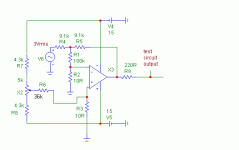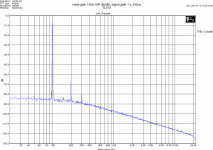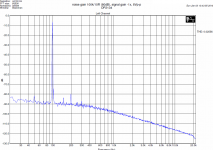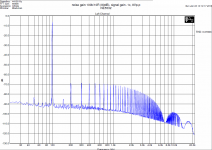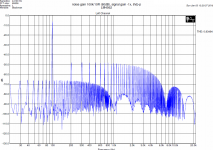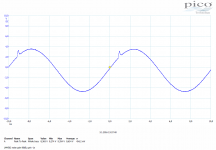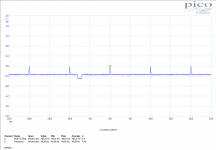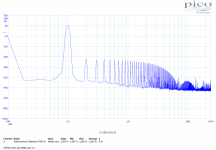Pavel, we live and learn and still die stupid, as my grandma used to say.
For a long time, I absolutely hated the sound of Burr-Brown's OP 134 family of op amps, it had come to the point that on occasion, I could actually detect them ina circuit.
To me, NAD was just anothe mee-too wannabe, which capitalized on its 20W integrated from the mid-70ies, which made good sound when it shouldn't have.
Then by chance I came across their C 565BEE DC player. It uses a Wolfoson AD converter and is chock-full of those nasty BB op amps I hate. And it sounds WAY better that I would ever expect it to, no nasties such as Richard attributed to the OPPO. It certainly plays better music than any other NAD CD player I ever heard, including their more to much more expensive models. Gives me what sounds like a superbly flat response at virtually any level short of rattling my window panes, lots of "air", plenty of detail and no degradation as we move up the frequency scale. Nevertheless, I would still hesitate to pronounce it to be equal to my recently serviced Dual DD TT, equipped with a brand new Ortofon M2Blue cartridge equalised by the phono stage of my Luxman C-03 preamp, but I will say it comes awfully close, with no usual connercial grade pitfalls. I wonder what will happen once the preamp has been refreshed with new caps, the next item on my to-do list (using exact type and model replacements).
Richard, I strongly suggest you find a NAD C 565BEE player just for comparison. AFAIK it was regularly sold in North America, so while it may not be easy to grab hold of one, it should still be possible. I think you would be quite surprised (for the better, of course). You too, JC. If nothing else, it will present to you a different point of view well worth hearing.
For a long time, I absolutely hated the sound of Burr-Brown's OP 134 family of op amps, it had come to the point that on occasion, I could actually detect them ina circuit.
To me, NAD was just anothe mee-too wannabe, which capitalized on its 20W integrated from the mid-70ies, which made good sound when it shouldn't have.
Then by chance I came across their C 565BEE DC player. It uses a Wolfoson AD converter and is chock-full of those nasty BB op amps I hate. And it sounds WAY better that I would ever expect it to, no nasties such as Richard attributed to the OPPO. It certainly plays better music than any other NAD CD player I ever heard, including their more to much more expensive models. Gives me what sounds like a superbly flat response at virtually any level short of rattling my window panes, lots of "air", plenty of detail and no degradation as we move up the frequency scale. Nevertheless, I would still hesitate to pronounce it to be equal to my recently serviced Dual DD TT, equipped with a brand new Ortofon M2Blue cartridge equalised by the phono stage of my Luxman C-03 preamp, but I will say it comes awfully close, with no usual connercial grade pitfalls. I wonder what will happen once the preamp has been refreshed with new caps, the next item on my to-do list (using exact type and model replacements).
Richard, I strongly suggest you find a NAD C 565BEE player just for comparison. AFAIK it was regularly sold in North America, so while it may not be easy to grab hold of one, it should still be possible. I think you would be quite surprised (for the better, of course). You too, JC. If nothing else, it will present to you a different point of view well worth hearing.
Pavel, they have listened to you and chip has been obsoleteralized, but agreed, it picks up your cell phone quicker than you can. Plus, in real time applications I have seen it beaten by a NE5532 on distortion.
Are you serious that they have listened to my comments on the EMI pick-up? I would like to explain the method I use, together with some results. I have been testing opamps by this method since the year 2008. The test circuit has 80dB noise gain and signal gain is -1x. Scott would recognize the circuit fort testing OP27 DC linearity, I would guess. However, as a secondary use, it reveals opamp EMI susceptibility ....
I use 100Hz input signal and output is about 8Vp-p (2.828Vrms). Output spevtrum is measured and in case of problems oscilloscope time plot as well.
JFET opamps pass this test very well, even the TL072. Please see the results for TL072 and OP2134. I have repeated the test today again, to verify my previous results.
Attachments
Now, BJT input opamps - and it is a completely different story. Same setup, nothing has changed, only opamps in the socket. See NE5532 and LM4562 results. For LM4562, I am attaching the time record as well, to see what is happening. The 100Hz peaks are slowly traveling along the curve shape. Together with slower, almost rectangle superimposed peak (not seen in this plot).
Should be said that AD797 and LT1028 do not have this strange behavior.
Should also be said that I have several production series of LM4562, since 2008 till about 2012 years, and all behave the same. All bought from authorized distributors.
Should be said that AD797 and LT1028 do not have this strange behavior.
Should also be said that I have several production series of LM4562, since 2008 till about 2012 years, and all behave the same. All bought from authorized distributors.
Attachments
Last edited:
Should be said that AD797 and LT1028 do not have this strange behavior.
Should also be said that I have several production series of LM4562, since 2008 till about 2012 years, and all behave the same. All bought from authorized distributors.
I would consider such behavior as broken i.e. consider a mask rev to fix. These problems do not show up in only one circuit but wait to get you.
I would consider such behavior as broken i.e. consider a mask rev to fix. These problems do not show up in only one circuit but wait to get you.
But they are not broken. They measure absolutely in specs in some of the usual tests, like gain 20dB. But in this noise gain 80dB/ gain -1x this was revealed (better say this has been measured for 7 years with different sound cards, with fast D/A oscilloscope and changes in test fixture). Please note it is a different test circuit than the manufacturer shows in his datasheet.
About 15 pcs of LM4562, from different production S/N, during 7 years. Several NE5532, some OPA211, all the BJT opamps show more or less this behavior. None of the JFET input opamps does the same.
The EMI may arrive in through supply or through the air. The test PCB is above 20 x 30 cm approx Aluminum sheet. GND connected to this Al sheet. Catching Al in the hand may change amplitude of interferences. However, no JFET opamps does it. It just shows much lower susceptibility of JFET opamps to EMI. And CD players are full of EMI. Take it as a magnifying lens that just enlarges some kind of behavior.
Attached is a time plot for LM4562 with no input signal, in this test circuit. See both 100Hz peaks and low frequency square that results in that LF comb in previous 4562 spectrum.
Attachments
Last edited:
Are you serious that they have listened to my comments on the EMI pick-up? I would like to explain the method I use, together with some results.
Interesting test, but is it a good test for EMI susceptibility?
Please explain your logic.
Interesting test, but is it a good test for EMI susceptibility?
Please explain your logic.
I assume yes, though it is not seen in usual circuit use and remains hidden.
Remember phono preamps with early BJT opamps? They picked AM radio stations. Switched to JFET opamps the problem has gone. I know some guys still complain about AM radio pickup?
I assume yes, though it is not seen in usual circuit use and remains hidden.
Remember phono preamps with early BJT opamps? They picked AM radio stations. Switched to JFET opamps the problem has gone. I know some guys still complain about AM radio pickup?
Actually, what I remember the best was the performance of a certain discrete transistor amp (in a Heath AR15) that picked up a very close AM station. This was when I lived in Pontiac while attending University.
A PI network low pass filter based on a hand-wound toroid and a 100 pF NPO cap solved the problem.
I never had any phono preamp EMI problems before or since and this was with a variety of tubed and SS preamps.
I had a NE 5534 op-amp based phono preamp that I both used at home and also carried around the Detroit area for the SMWTMS phono cartridge ABX tests and never had EMI problem number one.
Well, I have used a lot of bipolar opamps, including 5532,34 and the LM4562 and 49710and more recently the AD797. For audio way back I also used the LF series JFET op-amps. My main motivation for using bipolar opamps has been the good noise performance from moderate to low Z source - like a 10k pot which at electrical mid point is c. 2.5k Ohms. This really suits bipolar input devices wrt noise performance. I have never felt that bipolar opamps suffered in any way sonically compared to any other type of circuit - discrete or JFET types.
I have not had any problems with RF ever. But, I ALWAYS precede any inputs from the outside world with an RC filter, and have no qualms in using SMD ferrites if needed. I keep the feedback junctions very close to the feedback inverting inputs.
Your findings are interesting Pavel but the circuit is not representative of normal operation.
In the absence of any other theories, I would posit that what you are seeing is a very small signal current riding on top of a relatively high bipolar input bias current. The opamp loop gain as seen by the inverting input is not enough to override the bias current and as a result you get the problem you show. My guess is if you heat the JFET opamps up to c. 100 degrees C, you may see similar behavior as their bias current increases.
Nevertheless, your findings reflect reality and getting to the root cause will be interesting.
I have not had any problems with RF ever. But, I ALWAYS precede any inputs from the outside world with an RC filter, and have no qualms in using SMD ferrites if needed. I keep the feedback junctions very close to the feedback inverting inputs.
Your findings are interesting Pavel but the circuit is not representative of normal operation.
In the absence of any other theories, I would posit that what you are seeing is a very small signal current riding on top of a relatively high bipolar input bias current. The opamp loop gain as seen by the inverting input is not enough to override the bias current and as a result you get the problem you show. My guess is if you heat the JFET opamps up to c. 100 degrees C, you may see similar behavior as their bias current increases.
Nevertheless, your findings reflect reality and getting to the root cause will be interesting.
Last edited:
JFET opamps pass this test very well, even the TL072. Please see the results for TL072 and OP2134. I have repeated the test today again, to verify my previous results.
When and how do you use the X2 dc control pot in your test setup? And, is there a dc level which changes the EMI results?
Could you use the DC level to explore the threshold differences between bipolar and jFET?
THx-RNMarsh
Last edited:
The pot is needed to compensate for Vos, because of the enormous noise gain. However, with JFET input opamps, 100Hz and multiples are never present, regardless pot position. With BJT input opamps, 100Hz and multiples are always present, regardless pot position. The notable exceptions are AD797 and LT1028. LM4562 (LM49710) has the worst behavior from all opamps I have measured so far, in 7 years.
I guess that 100Hz and multiples are caught from air (like if you place open oscilloscope probe on the table) or they come through power supply. Power supply is stabilized, but only 7815/7915. The 100Hz multiples are there, with BJT input opamps, even if the input is shorted and no generator (no additional wires) connected to the input. So the only paths are through the air or supply.
Input saturated by EMI superimposed on 50 or 100Hz? FB action lost? What do you think?
I guess that 100Hz and multiples are caught from air (like if you place open oscilloscope probe on the table) or they come through power supply. Power supply is stabilized, but only 7815/7915. The 100Hz multiples are there, with BJT input opamps, even if the input is shorted and no generator (no additional wires) connected to the input. So the only paths are through the air or supply.
Input saturated by EMI superimposed on 50 or 100Hz? FB action lost? What do you think?
Last edited:
It's a little hard to make out on the schematic with the available resolution, but it looks like the offsets should be subtracted out by the final op amp. So the output is likely close to zero volts.Richard,
In this schematic Audiophile Musings: Another OPPO Mod you can see where the offset voltage is connected to (look at U24 and 25). I don't know what level the offset voltage is at, but I presume it is high enough to keep the polars c93 and 94 happy. If this is the case, all the voltage swing may be kept in the positive half of the opamp's potential. It's a bit of a guess, you would have to measure. Question for me is: would such a setup have similar effect as biasing the opamp into class A by pulling a constant current from the output, that is, to prevent crossover switching between the output tors? That would seem to be the case.
I'd conjecture airborne diode reverse recovery spikes and HF ringing, being envelope-detected by the op amp front ends.The pot is needed to compensate for Vos, because of the enormous noise gain. However, with JFET input opamps, 100Hz and multiples are never present, regardless pot position. With BJT input opamps, 100Hz and multiples are always present, regardless pot position. The notable exceptions are AD797 and LT1028. LM4562 (LM49710) has the worst behavior from all opamps I have measured so far, in 7 years.
I guess that 100Hz and multiples are caught from air (like if you place open oscilloscope probe on the table) or they come through power supply. Power supply is stabilized, but only 7815/7915. The 100Hz multiples are there, with BJT input opamps, even if the input is shorted and no generator (no additional wires) connected to the input. So the only paths are through the air or supply.
Input saturated by EMI superimposed on 50 or 100Hz? FB action lost? What do you think?
If you have any noise arising between the feedback junction and the inverting input, you will amplify it by the loop gain (inverting function).
If those plots that a Pavel is showing are caused by stray RF demodulation then it's easy enough to test by screening the test fixture. I assume this was how the tests were done in any event.
By the way, are the resistors being used SMD or leaded?
If those plots that a Pavel is showing are caused by stray RF demodulation then it's easy enough to test by screening the test fixture. I assume this was how the tests were done in any event.
By the way, are the resistors being used SMD or leaded?
Last edited:
It's a little hard to make out on the schematic with the available resolution, but it looks like the offsets should be subtracted out by the final op amp. So the output is likely close to zero volts.
You are correct. As we say in Dutch "I wasn't looking beyond the length of my nose".
- Status
- Not open for further replies.
- Home
- Member Areas
- The Lounge
- John Curl's Blowtorch preamplifier part II
